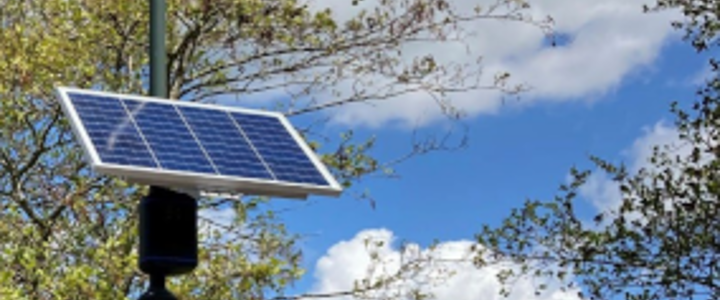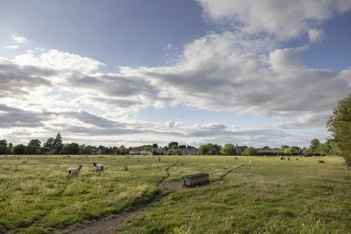News release from: 07/12/2023
Climate committee recommends stricter air quality standards

South Cambridgeshire District Council’s Climate and Environment Advisory Committee have given their backing to the development of a new Air Quality Strategy, with stringent targets in-line with World Health Organisation aspirations.
They’ve recommended that the Council works with Cambridge City Council to develop a joint strategy covering Greater Cambridge. Cambridge City Council agreed a similar joint approach at their Environment and Community Scrutiny Committee back in October.
Research by the Committee on Medical Effects of Air Pollution concludes that even low concentrations of pollutants are likely to be associated with adverse effects on health.
As a rural district, South Cambridgeshire’s air quality is generally good. However, the District Council has an important role in tracking and helping to maintain or improve air quality. The Council primarily monitors two key pollutants. These are nitrogen dioxide, which is linked to vehicle exhaust emissions - especially diesel vehicles, and particulate matter (PM2.5) which can come from a range of sources including vehicles, domestic wood burning and industrial processes.

Currently, World Health Organisation (WHO) air quality targets from 2021 set higher air quality standards than our national objectives. Adopting the WHO targets would set a long-term target for air quality improvements in the Greater Cambridge area. It would also aim to help prevent pollution levels from increasing as new homes come forwards in Greater Cambridge – which is one of the most economically successful and fast-growing areas in the UK.
It is anticipated that the joint strategy will have four main aims:
- The first priority would be linked to the planning system – with a focus on designing out air quality impacts during the construction of new developments.
- The second focus would be centred around working with partners to bring forwards new transport links so that residents are given the choice of a wider range of sustainable transport options – such as improved bus services and cycle links.
- Priority number three is envisaged to focus on raising further awareness of air quality locally – and providing information about how residents can help improve it, such as through not sitting in cars with engines running and burning the most environmentally-friendly fuels in wood burners.
- Finally, the fourth pillar would prioritise an up to date and robust air quality monitoring network.
The Chair of South Cambridgeshire District Council’s Climate and Environment Advisory Committee, Cllr Pippa Heylings, said: “The reality is there is no ‘safe’ level when it comes to air pollution. That’s why it has been one of our key objectives for several years to track and help maintain South Cambridgeshire’s air quality. Our Committee was unanimous in recommending that we work with our partners at Cambridge City Council towards a new joint air quality strategy that sets higher standards than currently demanded nationally. This is particularly important around schools because children are amongst the most vulnerable to air pollution. Because of this, and following understandable concerns from parents and carers, we have studied air quality at several schools in the district – with more monitoring to come.
“Another key area is raising awareness of how we can all play our part in cleaner air – and ideally this will mean burning less wood as fuel at home as domestic burning is now the single biggest source of particulate matter pollution in the UK. However, we appreciate that we’re now well into the colder weather and many South Cambridgeshire residents rely on solid fuel appliances like wood burners to keep warm. One thing that anyone with a wood-burner can do right away to contribute to cleaner air is to ensure they’re using appropriate fuel. We always recommend you look for the ‘ready to burn’ logo – and ensure the fuel that you burn is seasoned and doesn’t have more than 20% moisture. Finally, have your appliance swept every year for a cleaner burn too.”
Cllr Rosy Moore, Executive Councillor for Climate Action and Environment at Cambridge City Council, said: “Air Quality has no boundaries so we are really pleased to be working with South Cambridgeshire District Council to develop a new and joint Air Quality Strategy. The joint strategy would allow for an integrated approach to bringing down the levels of air pollution in Cambridge and South Cambridgeshire, which will help us to protect residents from the damaging impact that air pollution has on physical and mental health.”
The recommendations from South Cambridgeshire District Council’s Climate and Environment Advisory Committee will now go forwards to be considered by the District Council’s Lead Cabinet Member for Environment, Cllr Brian Milnes. Residents would be able to comment on the proposed new joint strategy during a public consultation next year.
South Cambridgeshire District Council uses a variety of air quality monitoring equipment, including:
- Cutting edge real time monitors in Harston, Impington and Northstowe.
- Portable monitors to measure more localised air pollution concerns that residents may have.
- 31 diffusion tubes which are currently located in 18 towns and villages.
The District Council has completed air quality studies at six schools. These are in Cambourne, Harston, Histon, Milton, Northstowe and Swavesey with the reports from each school available online. Find more information about air quality in South Cambridgeshire.
